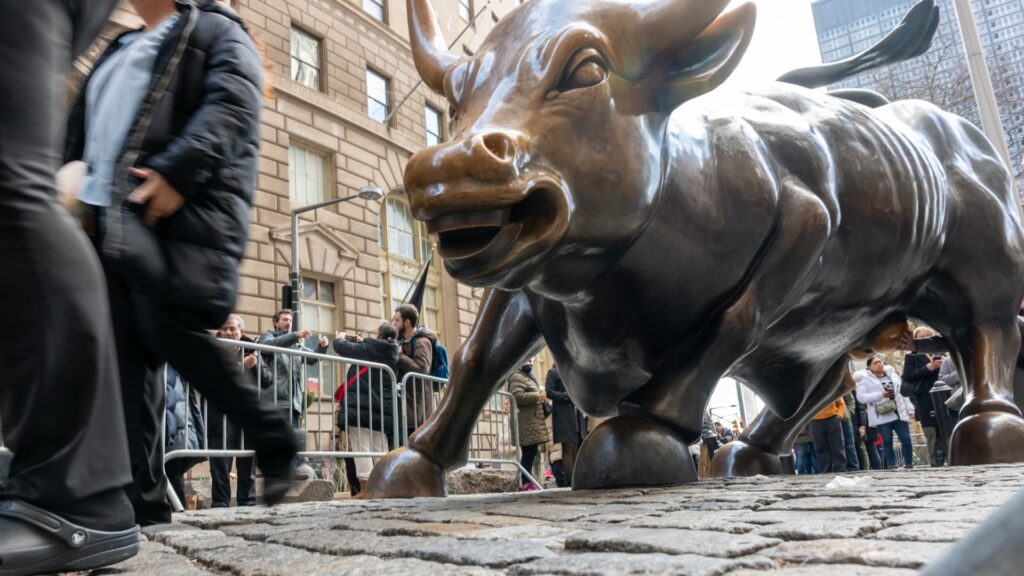
Wall Street is heading into the final trading week of March with momentum on its side. All seems to be going well for markets lately. The Federal Reserve this week said it remains on track to lower interest rates this year as inflation, while sticky, eases off its highs. What’s more, artificial intelligence has continued to act as jet fuel for equities, in spite of concerns the trade is crowded. Just this week, the major averages notched fresh all-time closing highs, as tech stocks surged. The Dow Jones Industrial average even flirted with the 40,000 level. .DJI YTD mountain Dow, YTD The broad stock market benchmark, the S & P 500, has already blown past the year-end forecasts of many strategists. On average, the smart money expects the broader index will end the year at 5,032, CNBC’s Market Strategist Survey shows. But the S & P 500 was last floating above 5,200. And, this week, Societe Generale joined other Wall Street firms in raising its year-end forecast , to 5,500, citing the contributions AI will make to corporate profits. For many investors, there’s no reason not to expect that enthusiasm won’t carry into next week. Stocks are set to close out another winning month that, notably, saw the rally expand to other parts of the market, a sign that the trend remains to the upside. This month, the S & P 500 Equal Weighted Index has gained 3.4% thus far, better than the 2.7% advance registered by the market-weighted index. “That broad-based strength is one indicator suggesting that the breadth is improving,” said Terry Sandven, chief equity strategist for U.S. Bank Wealth Management. “So, I think we’re ending the month with a lot of positive signals for an equity market that wants to trend higher.” “This is a Goldilocks market,” Sandven added. .SPX YTD mountain S & P 500 On Friday, the major averages registered a winning week . The Dow Jones Industrial Average closed out its best week of the year, up by about 2%. The S & P 500 and Nasdaq Composite each notched a more than 2% advance. Optimism shooting higher If anything, it’s the optimism that has some investors concerned markets could be overextended. Investor sentiment remains above its historical average, according to the American Association of Individual Investors Sentiment Survey (AAII). “Probably our biggest worry now is that so many bears that have capitulated this year now have targets higher than ours,” John Stoltzfus, chief market strategist at Oppenheimer, told CNBC’s “Squawk on the Street” on Friday. The strategist, who has a 5,200 S & P 500 year-end target, remains bullish on markets, but noted, “When everybody joins the same side of the boat, it certainly says we’ve got to consider what’s going on.” Other market observers remain concerned that investors are underestimating the impact of higher-for-longer interest rates on the economy, which they expect will eventually show signs of weakness that require greater than three rate cuts from the Fed. Some recent earnings results have highlighted growing pressure on consumers. This week, executives at Darden Restaurants, the parent company behind Olive Garden, reported a revenue miss, citing a pullback in restaurant spending from lower-income consumers. “One of our primary concerns is that there’s significant parts of the economy that are just not workable at the restrictive rates that we’ve had,” said Nathan Kotler, head of trading at GenTrust. “So this leads us to have a higher-than-expected recession risk penciled in, relative to the market.” Fresh inflation data Next week will bring more inflation news in the form of the February personal consumption expenditures price index, the Fed’s preferred inflation gauge, which will give investors another look into whether inflation is indeed easing enough for the central bank to cut rates eventually this year. Bank of America expects that headline PCE will come in at 0.4% on a monthly basis, while core PCE prints at a softer 0.3%, a reading the Wall Street firm expects will keep the central bank on pace to cut starting in June. As the report will be released Friday, during the Good Friday holiday when markets are closed, equities will price in any reaction to the report the following trading day, on Monday. If the central bank is on pace to cut rates this year, with no ensuing recession, that could mean further good news for investors, as history shows the economic cycle can get extended, Barclays’ Emmanuel Cau wrote on Friday. The notable comparison is in 1995, when markets continued to rally following a period of easing. “I don’t see an end to this bull market right now,” said Jeff Hirsch, editor of the Stock Trader’s Almanac. “Other than some, you know, slight consolidation and pause over the worst six months, I don’t see any major correction on the horizon.” Week ahead calendar All times ET. Monday, March 25 8 a.m. Building Permits final (February) 8:30 a.m. Chicago Fed National Activity Index (February) 10 a.m. New Home Sales (February) 10:30 a.m. Dallas Fed Index (March) Tuesday, March 26 8:30 a.m. Durable Orders preliminary (February) 9 a.m. FHFA Home Price Index (January) 9 a.m. S & P/Case-Shiller comp.20 HPI (January) 10 a.m Consumer Confidence (March) 10 a.m. Richmond Fed Index (March) Earnings: McCormick & Co. Wednesday, March 27 No notable events. Earnings: Carnival Thursday, March 28 8:30 a.m. Continuing Jobless Claims (3/16) 8:30 a.m. GDP Chain Price final (Q4) 8:30 a.m. GDP (Q4) 8:30 a.m. Initial Claims (3/23) 9:45 a.m. Chicago PMI (March) 10 a.m. Michigan Sentiment final (March) 10 a.m. Pending Home Sales Index (February) 11 a.m. Kansas City Fed Manufacturing Index (March) Earnings: Walgreens Boots Alliance Friday, March 29 Markets are closed for Good Friday. 8:30 a.m. PCE Deflator (February) 8:30 a.m. Personal Consumption Expenditure (February) 8:30 a.m. Personal Income (February) 8:30 a.m. Wholesale Inventories preliminary (February)






